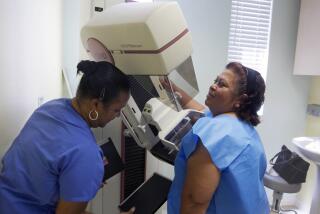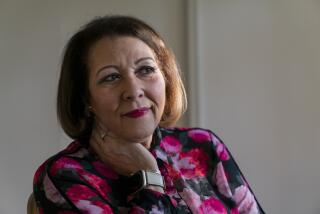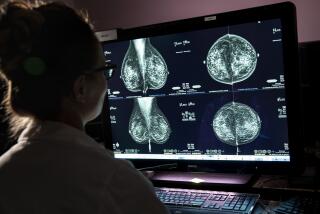Mammograms of Little Use to Women Under 30
SAN FRANCISCO â A three-year study shows mammograms are of little use in detecting breast cancer in women under 30, a researcher reported.
âThe notion that because a mother is found to have breast cancer it is prudent to X-ray her daughterâs breasts right then when sheâs 22 rather than waiting until she is 35 or 40 is simply not true,â said Dr. Thomas Lee Pope Jr., of the University of Virginia Medical Center in Charlottesville.
âThe study shows mammography is not very useful for women under 30,â said Pope, who undertook the project because âwe had been getting a lot of referralsâ for women in their 20s to have a mammogram and wanted to determine the techniqueâs effectiveness in those cases.
The researcher cautioned physicians âto avoid unnecessarily radiating women in this younger age group.â
The study of 178 patients showed the majority of mammograms in women under 30 were normal, the majority of lesions felt in the women were not seen on the mammogram and the masses that did show up were non-cancerous.
âOf the four women in our group who had cancer, none was diagnosed here,â Pope reported at the recent meeting of the American Roentgen Ray Society.
Only 20% of breast lumps found during self-examination showed up on the mammogram, a low-dose breast X-ray used in identifying cancers too small to be felt, he said.
âYoung women tend to have very dense breasts so that a mammogram will be less sensitive and yield less diagnostic information than another method might,â such as self-examination, said Pope, noting that 80% of breast cancers are detected by the patients themselves.
Mammography is far more effective in older women. Levels of the hormone estrogen--which stimulates the growth of glandular tissue cells in the breast--diminish during menopause, and, generally, breast density decreases with age, he said.
In addition, the rate of breast cancer is low in the under-30 group. One in 200,000 among 20- to 24-year-olds and nearly 5 in 200,000 among 25- to 29-year-olds have the disease, which kills 42,000 American women each year.
The American College of Radiology and the American Cancer Society recommend women undergo breast X-rays every two years between ages 40 to 50 and annually thereafter.
Monthly self-examination and regular medical checkups should suffice for younger women, Pope said.
Any lumps should first be examined through ultrasound, which uses high-frequency sound waves to produce a picture, and which detected 7% of the lesions felt by the patients but not seen on the mammograms, he said.
The study, performed between 1984 and 1987, examined 184 mammograms of 178 patients. Of these, 83 were of women who had detected a lump in their breast; 59 of those who had felt nothing; and 42 of those with an âindeterminate mass,â which the doctor could not initially identify.
In the first group, only 20% of the 83 lumps felt in the breasts showed up on the X-ray, while 75% of the mammograms were normal. Four women in the group had cancer but were diagnosed by other means.
In the second group consisting mostly of patients referred for mammograms because of family histories of breast cancer, 88% of the X-rays appeared normal. The mammograms of four women showed masses, which turned out to be non-cancerous.






